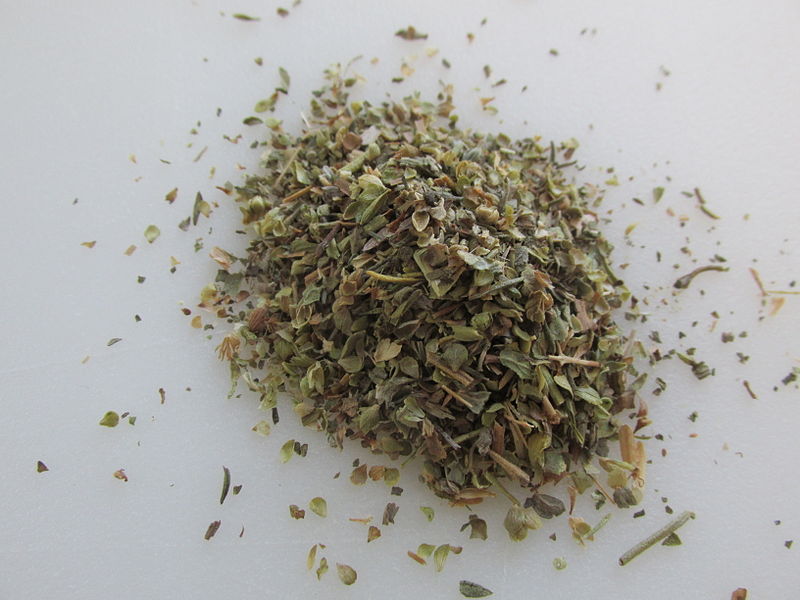That jar of Italian Seasoning in your cupboard sees a lot of use. Take a look at the label. All of the ingredients are probably already growing in your herb garden. And if they aren’t, they should be. All of the herbs in Italian Seasoning are easy to grow.
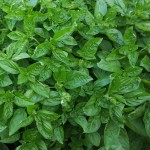 Basil (Ocimum basilicum) Originally from Southeast Asia, it is an annual growing to 18 to 24 inches tall, depending on the variety. Basil is easy to grow from seed. The seeds should be started indoors about 8 weeks before your last frost date. Transplant the seedlings into your garden when night time temperatures are above 60°F. It is a tropical plant so basil likes lots of heat, lots of sun and lots of water. Be vigilant about removing the flowers. Once the plant flowers, the leaves start to lose their flavor.
Basil (Ocimum basilicum) Originally from Southeast Asia, it is an annual growing to 18 to 24 inches tall, depending on the variety. Basil is easy to grow from seed. The seeds should be started indoors about 8 weeks before your last frost date. Transplant the seedlings into your garden when night time temperatures are above 60°F. It is a tropical plant so basil likes lots of heat, lots of sun and lots of water. Be vigilant about removing the flowers. Once the plant flowers, the leaves start to lose their flavor.
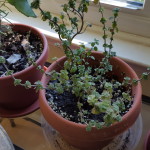 Sweet Marjoram (Origanum majorana) is native to Cyprus and southern Turkey and a member of the oregano family with a milder, sweeter flavor than oregano. It is a tender perennial hardy only through zone 7. North of zone 7, it is usually grown as an annual or it can be brought indoors provided it has enough light. Supplemental lighting is recommended. Mature plants reach a height of 1 to 2 feet. Marjoram is happiest in full sun and dry soil. It can be grown from seed but you must be patient. The seeds are slow to germinate.
Sweet Marjoram (Origanum majorana) is native to Cyprus and southern Turkey and a member of the oregano family with a milder, sweeter flavor than oregano. It is a tender perennial hardy only through zone 7. North of zone 7, it is usually grown as an annual or it can be brought indoors provided it has enough light. Supplemental lighting is recommended. Mature plants reach a height of 1 to 2 feet. Marjoram is happiest in full sun and dry soil. It can be grown from seed but you must be patient. The seeds are slow to germinate.
 Oregano (Origanum vulgare) Most cooks prefer Italian oregano but if you want a bigger flavor, I recommend using Greek oregano (O. vulgare spp hirtum) which has a stronger flavor. Both are drought tolerant, require full sun and are hardy through zone 5. Like basil, the leaves will become bitter tasting after the plants blooms so prune away any buds before they open into flowers. Oregano is a member of the mint family. It will readily spread in your garden and may become invasive.
Oregano (Origanum vulgare) Most cooks prefer Italian oregano but if you want a bigger flavor, I recommend using Greek oregano (O. vulgare spp hirtum) which has a stronger flavor. Both are drought tolerant, require full sun and are hardy through zone 5. Like basil, the leaves will become bitter tasting after the plants blooms so prune away any buds before they open into flowers. Oregano is a member of the mint family. It will readily spread in your garden and may become invasive.
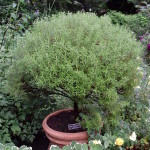 Rosemary (Rosmarinus officinalis) is native to the Mediterranean area. It is a woody perennial that is reliably hardy through zone 7. It can survive mild winters with protection in zone 6. In northern areas, rosemary should be grown in pots and brought inside once the outdoor temperatures are lower than 30°F. Mature plants grown outside can reach a height of 5 feet. Rosemary requires full sun. It is also drought tolerant. Pale blue flowers appear in early spring. It is often used as an ornamental shrub because it can be pruned into hedges and topiary. Rosemary is usually propagated by cuttings.
Rosemary (Rosmarinus officinalis) is native to the Mediterranean area. It is a woody perennial that is reliably hardy through zone 7. It can survive mild winters with protection in zone 6. In northern areas, rosemary should be grown in pots and brought inside once the outdoor temperatures are lower than 30°F. Mature plants grown outside can reach a height of 5 feet. Rosemary requires full sun. It is also drought tolerant. Pale blue flowers appear in early spring. It is often used as an ornamental shrub because it can be pruned into hedges and topiary. Rosemary is usually propagated by cuttings.
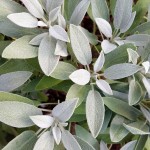 Sage (Salvia officinalis) is native to the Mediterranean but has naturalized throughout much of the world. It is a perennial sub-shrub that is hardy through zone 5. The plants become woody within three to four years and will need to be replaced. Mature plants reach a height of 3 feet in full sun or partial shade. They are drought tolerant. Sage has typical salvia type flowers usually in blue, but they can range in color from white to pink to lavender. Bloom time is late spring to early summer. Sage is easy to grow from seeds. You can direct sow your seeds in the fall or start them indoors 6 to 8 weeks before your last frost.
Sage (Salvia officinalis) is native to the Mediterranean but has naturalized throughout much of the world. It is a perennial sub-shrub that is hardy through zone 5. The plants become woody within three to four years and will need to be replaced. Mature plants reach a height of 3 feet in full sun or partial shade. They are drought tolerant. Sage has typical salvia type flowers usually in blue, but they can range in color from white to pink to lavender. Bloom time is late spring to early summer. Sage is easy to grow from seeds. You can direct sow your seeds in the fall or start them indoors 6 to 8 weeks before your last frost.
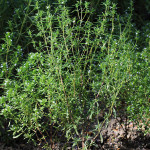 Savory– a member of the mint family, savory comes in two varieties: summer savory (Satureja hortensisa), which is an annual, and winter savory (Satureja montana), which is a perennial. Despite being members of the mint family, neither one is invasive. For your Italian Seasoning, you want to grow summer savory. Mature plants will reach 18 inches in height. Once established, summer savory prefers to be dry. This makes it perfect for container growing since containers dry out quickly if you don’t water every day. Summer savory is easily grown from seed. You can either direct sow the seeds in your sunny garden after the last frost or you can start them indoors 4 to 6 weeks before the last frost. Be patient! Summer savory seeds are slow to germinate.
Savory– a member of the mint family, savory comes in two varieties: summer savory (Satureja hortensisa), which is an annual, and winter savory (Satureja montana), which is a perennial. Despite being members of the mint family, neither one is invasive. For your Italian Seasoning, you want to grow summer savory. Mature plants will reach 18 inches in height. Once established, summer savory prefers to be dry. This makes it perfect for container growing since containers dry out quickly if you don’t water every day. Summer savory is easily grown from seed. You can either direct sow the seeds in your sunny garden after the last frost or you can start them indoors 4 to 6 weeks before the last frost. Be patient! Summer savory seeds are slow to germinate.
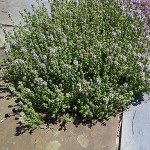 Thyme (Thymus vulgaris) is another Mediterranean native. A small shrubby perennial, it is hardy through zone 5. Mature plants range in size from 6 to 12 inches, depending on the variety. Note that there are two types of thyme, upright and creeping thyme. The upright thymes are used in cooking. Thyme prefers a sunny location, but it can tolerate a little shade. What it can’t tolerate is over watering. Thymes are drought tolerant plants. Thyme is most often propagated by cuttings because seed germination is not reliable and can take anywhere from 8 to 20 days. Cuttings should be started indoors 6 weeks before your last frost date. Seeds, which take longer to germinate, should be started 10 weeks before your last frost date. The resulting plants can be moved outdoors to your garden as early as 2 to 3 weeks before your last frost although they will grow best when the soil reaches 70⁰F.
Thyme (Thymus vulgaris) is another Mediterranean native. A small shrubby perennial, it is hardy through zone 5. Mature plants range in size from 6 to 12 inches, depending on the variety. Note that there are two types of thyme, upright and creeping thyme. The upright thymes are used in cooking. Thyme prefers a sunny location, but it can tolerate a little shade. What it can’t tolerate is over watering. Thymes are drought tolerant plants. Thyme is most often propagated by cuttings because seed germination is not reliable and can take anywhere from 8 to 20 days. Cuttings should be started indoors 6 weeks before your last frost date. Seeds, which take longer to germinate, should be started 10 weeks before your last frost date. The resulting plants can be moved outdoors to your garden as early as 2 to 3 weeks before your last frost although they will grow best when the soil reaches 70⁰F.
To make your Italian Seasoning, you will need to dry your herbs. This can be done in a few different ways. You can dry them in your oven, your microwave or in a food dehydrator. Then simply combine your herbs in a 1:1:1:1:1 mixture, for instance 1 tablespoon of each. Once you have made your Italian Seasoning mixture, place the mixture in an air tight container and store it in a cool, dark place with no sun exposure.
More Herb Blends
Bouquet Garni
Chinese Five Spice Blend
Curry Blend
Fines Herbes
Herbes de Provence
Old Bay Seasoning
Paprika
Poultry Seasoning
Za’atar

